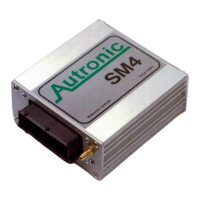
Do you have a question about the Autronica SM4 and is the answer not in the manual?
| Enclosure Material | Steel |
|---|---|
| Communication Interface | Ethernet (optional) |
| Display | LCD Display |
| Communication | RS-485, Ethernet |
| Power Supply | 24 V DC |
Important preparatory steps and advice before starting installation.
Step-by-step guide for installing the SM4 ECU with a flying lead harness.
Details on connecting various flying leads for ECU functionality.
Details on the MAP sensor, its function, and connection.
Information on installing and connecting the coolant temperature sensor.
Instructions for mounting, wiring, and testing the throttle position sensor.
Information on connecting crank and cylinder reference sensors for timing.
Requirements and installation steps for the Autronic software.
Choosing the correct injectors for optimal system performance.
Setting up crank and cam trigger patterns for accurate timing.
Procedures for successfully starting the engine after installation.
Guide to configuring the Air/Fuel ratio table for engine tuning.
Step-by-step process for manually tuning engine parameters.
Using the 'M' key for automated A/F ratio adjustments.
Utilizing logged data and mixture tables for tuning.
Using the software's auto-tuning feature for real-time calibration.
Mapping fuel delivery and ignition based on throttle or manifold pressure.
Guide to setting up an advanced launch control system.
Enabling and configuring boost control output.
Assigning outputs for boost control configuration.
Detailed explanation of boost setpoint tables and related parameters.
Configuring boost pressure targets based on engine parameters.
Setting the boost range parameter for wastegate regulation.
Fine-tuning boost pressure by correcting offsets.
Modifying boost pressure based on variables like intake temp or throttle.
Using the table for engine protection against high intake air temperatures.
Manually editing fuel table based on measured A/F ratio.
Configuring parameters for the Auto Tune function.
Viewing recorded fault codes and error conditions.
Core initial setup parameters for the ECU.
Configuration for ignition outputs and coil systems.
Selecting and configuring fuel injectors.
Configuring cylinder and sync patterns for accurate timing.
Configuring auxiliary input functions.
Enabling and configuring auxiliary output functions.
Setting up boost control using a PWM output.
Configuring analog inputs for various sensors.
Configuring high-speed inputs for sensors.
Enabling and configuring Closed Loop Control for air fuel ratio.
Setting up variable camshaft control.
Setting engine TDCs for ignition and fuel timing.
Setting base ignition timing angles.
Setting base injection timing angles.
Setting up the base ignition timing table.
Setting the optimum fuel injection angle.
Setting target Air/Fuel ratios for CLC and AutoTune.
Adjusting fuel delivery based on cylinder or auxiliary compensations.
Individual calibration trims for injector calibration differences.
Modifying ignition timing based on various factors.
Enabling and configuring the knock detection function.
Estimating charge air temperature based on engine conditions.
Configuring acceleration enrichment parameters.
Setting throttle position for part-throttle acceleration enrichment.
Adjusting fuel delivery for acceleration from closed throttle.
Adjusting fuel delivery for acceleration from part throttle.
Multiplier for warm-up enrichment based on temperature and load.
Multiplier for post-start enrichment based on temperature.
Warm-up acceleration enrichment multiplier.
Ignition timing for idle conditions.
Control of engine idle speed based on battery voltage.
Tuning the IAC parameters.
Tuning the boost controller and selecting boost setpoints.
Setting the boost range for wastegate regulation.
Defining boost setpoints based on vehicle speed per gear.
Defining boost setpoints based on vehicle speed per gear.
Setting boost control points relative to RPM and axis.
Correcting actual boost pressure against desired levels.
Modifying boost pressure based on other variables.
Setting engine limits like rev limiters and cut-offs.
Setting engine RPM limits against engine temperature.
Setting engine RPM limits against engine temperature.
Enabling and configuring the anti-lag system.
Adjusting ignition timing and retard for anti-lag.
Enabling the traction control system.
Tuning the traction control system parameters.
Enabling and configuring the launch control system.
Configuring Wide Open Throttle gear shifting.
Setting up variable camshaft control.
Accessing Logger menu functions.
Configuring PC warning display and item selection.
Setting up PC logger rate, trigger, and memory model.
Manual control of the PC logger.
Configuring channels, sample rate, and memory for ECU logging.
Ensuring sufficient injector flow capacity for engine demands.
Verifying the fuel pump's capacity to supply fuel.
Information on fuel rail diameter and pressure regulator selection.
Requirements and operation of dumb ignition modules with SM4.
Understanding trigger edges for ignition modules.
Using the Autronic CDI with SM4 for direct fire ignition.
How the SM4 receives trigger signals.
Types of sensors (Hall, Optical, Magnetic) for trigger signals.
Standard triggering method using one pulse per cylinder revolution.
Support for triggers with multiple evenly spaced events.
Specific trigger type using a missing tooth.
Explanation of frequently used analyzer functions.
Troubleshooting steps for communication issues between PC and ECU.
Diagnosing and fixing problems with the RPM signal.
Troubleshooting lack of spark or injector pulses.
How the ECU's LED indicates fault conditions.
Diagram illustrating boost control with an internal wastegate.
Diagram illustrating boost control with an external wastegate.